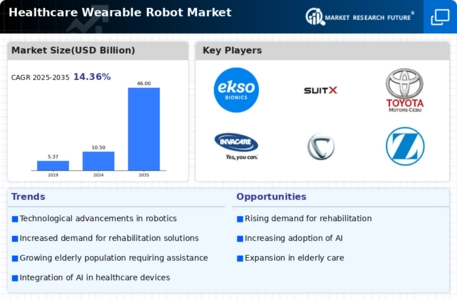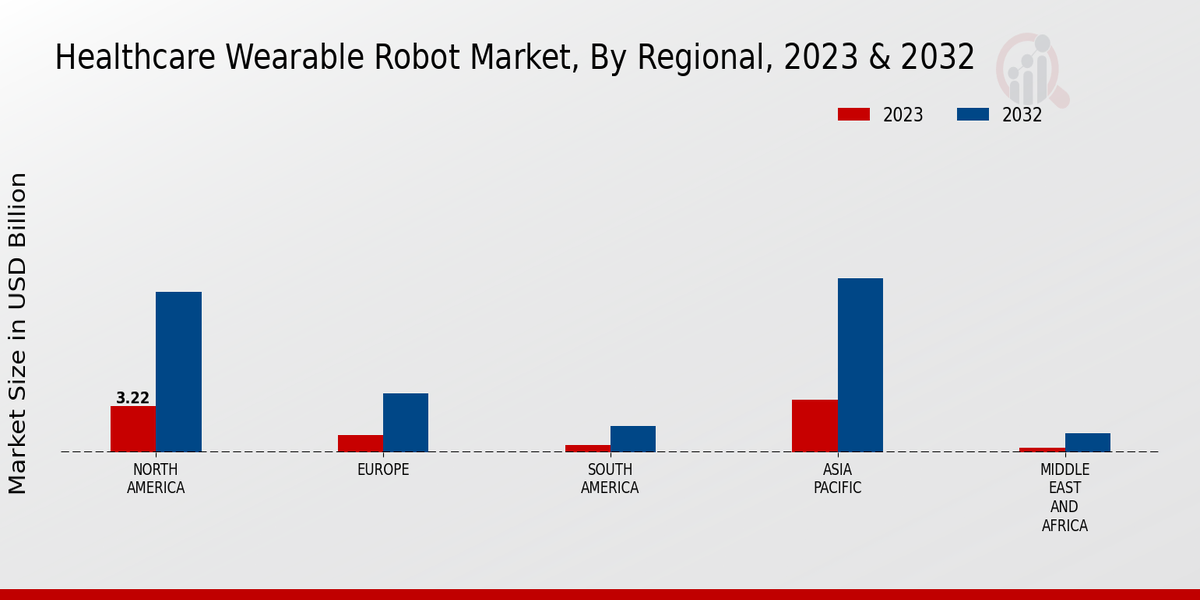Market Growth Projections
The Global Healthcare Wearable Robot Market Industry is projected to experience robust growth over the coming years. The market size is expected to expand from 10.5 USD Billion in 2024 to 46.0 USD Billion by 2035, reflecting a compound annual growth rate of 14.37% from 2025 to 2035. This growth trajectory indicates a strong demand for wearable robots across various healthcare applications, including rehabilitation, elderly care, and chronic disease management. As technological advancements continue to enhance the capabilities of these devices, the market is likely to attract significant investments, fostering innovation and expanding the range of available solutions.
Government Initiatives and Funding
Government initiatives and funding significantly bolster the Global Healthcare Wearable Robot Market Industry. Various countries are investing in research and development to promote the adoption of advanced healthcare technologies. For instance, initiatives aimed at enhancing patient care and reducing healthcare costs often include support for wearable robotics. These investments not only facilitate innovation but also encourage collaboration between public and private sectors. As governments recognize the potential of wearable robots to improve healthcare outcomes, funding is likely to increase, driving market expansion. The expected growth from 10.5 USD Billion in 2024 to 46.0 USD Billion by 2035 reflects the positive impact of such initiatives.
Technological Advancements in Robotics
Technological advancements play a pivotal role in propelling the Global Healthcare Wearable Robot Market Industry forward. Innovations in artificial intelligence, machine learning, and sensor technology enhance the functionality and efficiency of wearable robots. For instance, the integration of real-time data analytics allows these devices to adapt to users' needs dynamically. As a result, healthcare providers can offer more personalized care, improving patient outcomes. The continuous evolution of robotics technology is likely to attract investments and foster collaborations, further accelerating market growth. The anticipated increase in market size from 10.5 USD Billion in 2024 to 46.0 USD Billion by 2035 underscores the significance of these advancements.
Rising Demand for Elderly Care Solutions
The Global Healthcare Wearable Robot Market Industry experiences a notable surge in demand for solutions catering to the aging population. As the global demographic shifts, the number of individuals aged 65 and older is projected to reach 1.5 billion by 2050. This demographic change necessitates innovative healthcare solutions, including wearable robots that assist with mobility and daily activities. Such devices not only enhance the quality of life for seniors but also alleviate the burden on caregivers. The market is expected to grow from 10.5 USD Billion in 2024 to 46.0 USD Billion by 2035, reflecting a compound annual growth rate of 14.37% from 2025 to 2035.
Increasing Prevalence of Chronic Diseases
The Global Healthcare Wearable Robot Market Industry is significantly influenced by the rising prevalence of chronic diseases such as arthritis, stroke, and cardiovascular conditions. These ailments often lead to mobility challenges, necessitating assistive technologies for rehabilitation and daily living. Wearable robots provide essential support, enabling patients to regain independence and improve their quality of life. According to the World Health Organization, chronic diseases account for 71% of all deaths globally, highlighting the urgent need for effective management solutions. As healthcare systems increasingly adopt wearable robots to address these challenges, the market is poised for substantial growth, with projections indicating a rise from 10.5 USD Billion in 2024 to 46.0 USD Billion by 2035.
Growing Awareness and Acceptance of Wearable Technology
The Global Healthcare Wearable Robot Market Industry benefits from the growing awareness and acceptance of wearable technology among consumers and healthcare professionals. As individuals become more familiar with wearable devices, their willingness to adopt innovative solutions increases. This trend is particularly evident in rehabilitation settings, where wearable robots are increasingly recognized for their potential to enhance recovery outcomes. Educational campaigns and demonstrations have played a crucial role in dispelling misconceptions and showcasing the benefits of these technologies. As acceptance continues to rise, the market is likely to experience accelerated growth, with projections indicating a substantial increase from 10.5 USD Billion in 2024 to 46.0 USD Billion by 2035.




















